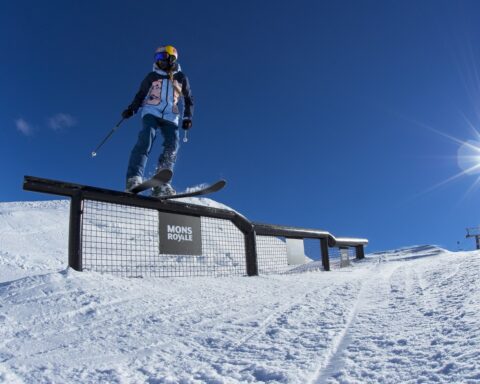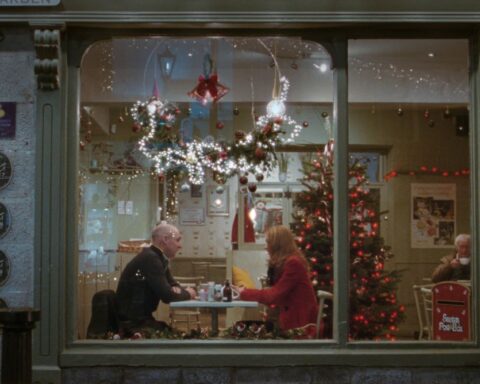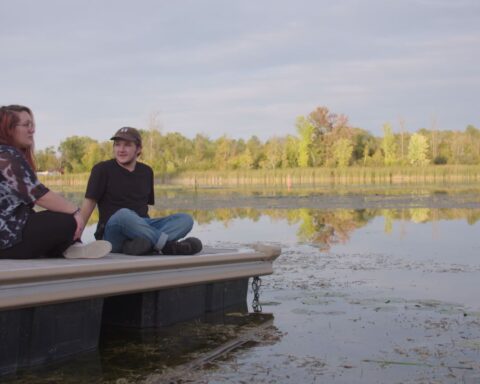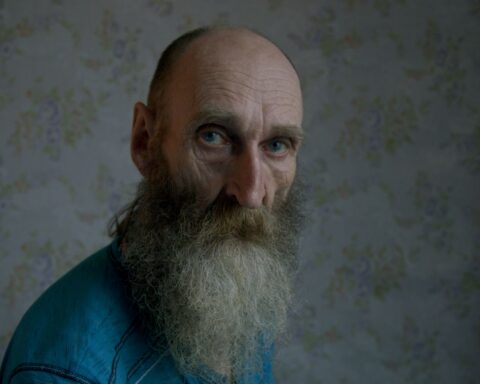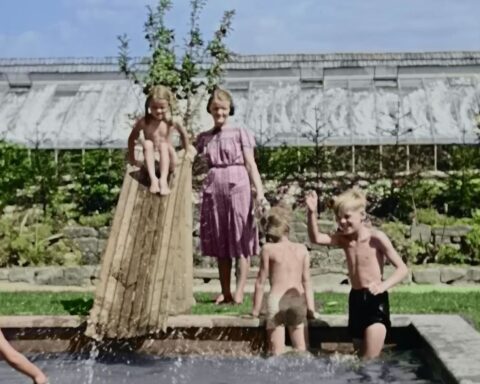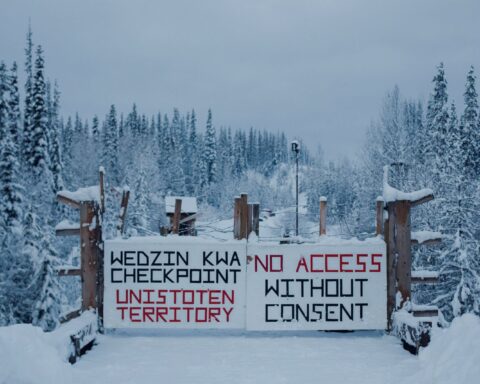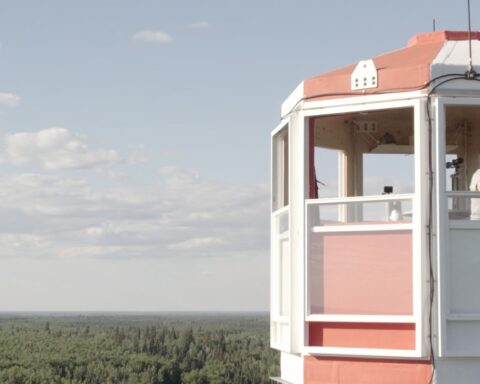This is a story about love—love between a man and a woman from vastly different worlds, love of family and love of multi-cultural Toronto. A good storyteller has the ability to gently open us up, touch our hearts and enhance the way we look at the world. But for real professionals, like Germany’s First Hand Films distributor Esther van Messel, the secret to a successful film is that it’s commercial and subversive. Sabah, the debut feature by writer-director Ruba Nadda, is likely to accomplish both goals. Though modest in scope, it’s a well-crafted romantic drama, entertaining and accessible, while also subverting the dominant, negative perception of Muslims in today’s post-9/11 world. This uplifting independent Canadian film reminds us that, regardless of race, religion or age, it’s never too late—to change, to fall in love, to make dreams come true.
In Arabic sabah means “morning,” and Sabah ’s main visual metaphor is of a delicate flower stretching toward the morning sun. Played by one of Canada’s finest actors, Arsinée Khanjian, Sabah is a dutiful daughter in a close-knit, immigrant Muslim family who lives at home taking care of her mother. But something’s missing: having resisted an arranged marriage, she’s never known love. On her fortieth birthday her over bearing brother Majid (played by Jeff Seymour), gives her a photograph of herself as a little girl in Syria, standing by the seashore with their now deceased father. The photograph awakens a remembrance in Sabah, and like the influential Syrian filmmaker Mohammad Malas, Nadda uses memory as a formal device to lead Sabah toward her future.
Fuelled by this long forgotten joy and sense of freedom, she secretly goes to a local pool. There, she meets Stephen, a Canadian non-Muslim (played by Shawn Doyle), who accidentally grabs her towel, her only protection in this foreign environment. Sabah takes a courageous first step toward her own happiness by gradually starting to talk to him. In doing so, she sets off a chain of events that eventually affects her entire family.
“Sabah, as a woman, gives me hope,” Khanjian comments. “Regardless of the nature of the obstacles, she is still going through a very personal journey of self-realization. Whatever choices Sabah makes, they are her own; no one is dictating to her. It’s not Stephen who opens up her world. She decides at this point in her life, things have to change.”
Thirty years ago Fatema Mernissi (winner of the 2004 Erasmus Prize) wrote in Beyond the Veil, “What modern Muslim societies ought to strive toward is a family based on the unfragmented wholeness of the woman. It implies and generates tenderness and love.” Sabah’s blossoming toward wholeness is gradual, therefore believable: a little more hair showing under her hijab (head covering), a little more red in her clothing, and a little more confidence. The film uses visual symbolism grounded in everyday life to enhance the psychological under pinnings of Sabah’s evolution. Water symbolizes rebirth and awakening. No longer satisfied with her sheltered, stagnant life, she dives into the deep blue of the unknown. Fadia Nadda, who plays Souhaire, Sabah’s beguiling nineteen-year old niece, says that, “in the original draft, Sabah falls in the water and Stephen rescues her, whereas now they just meet, which is more realistic. You don’t need to hurt yourself to fall in love.”
Sabah was shot last summer in downtown Toronto. The atmosphere amongst the cast and crew appeared to be one of creative camaraderie. There was no sign of egotistical affectation or autocratic melodrama on this set. “If you have a director that’s moody, you have a set that’s moody. But it’s been a laugh-fest. I haven’t felt one bump, one hiccup,” said Jeff Seymour at the time.
Shot over three weeks during a heatwave, Sabah ’s production was efficiently led by Nadda and producer Tracey Boulton. On their first day, they finished two hours ahead of schedule– a great way to start the shoot. “It was one of my most pleasant experiences shooting. These things always leave an impact, coming through in the film,” adds Khanjian. “Ruba worked hard to bring the story from this abstract sense of what that society is about to very basic elements that are true to all beings. And she’s given us room to emotionally enter this story.”
Federico Fellini once said, “The only visionary is the realist because he bears witness to his own reality.” Nadda writes what she knows. Like traditional Arab writers, she weaves together aspects of her own life with those of her characters, mixing dream into reality. Born in Montreal in 1972, of Syrian and Palestinian parents, Nadda moved around Canada a lot while growing up. From those experiences, she says, “I developed an acute sensitivity and empathy. I’m able to identify with people and put myself in their shoes. And I can take that and put it in a film.” Briefly living in Damascus atthe age of sixteen, Nadda learned just how precarious a girl’s freedom in a Muslim country is: she was almost married against her will. From that moment on she says, “I enveloped life. When you’ve almost had your independence taken away from you, you never want to go through that again.” Once, on the bus during her last year at York University she saw a Muslim woman in a burqua, completely covered head to toe; only her eyes were visible. Nadda wondered about the woman’s sexual urges and what would happen if she fell for the “wrong” man. That moment gestated within her, slowly forming into what would eventually become Sabah.
Like Rebecca Miller, another writer-director who draws on personal experience, Nadda has confidence in her material—and that has engendered greater collaboration. “Ruba was very open to feedback,” says Khanjian. “But she really had a point of view. She’s quite harsh when it comes to saying the truth of what is absurd in these realities, but at the same time, very respectful of it. It’s a combination of criticism with the heart in the right place.” Doyle agrees: “Ruba was really interested in any input to help flesh out the characters. I proceeded to put together a little essay about things I would change. She responded to them point by point and we ended up having a very healthy dialogue.” And the humour in Sabah rings true due to a blend of good writing, the comic timing of the performances and Teresa Hannigan’s skillful editing.
Nadda set out to create a film reminiscent of classic films from Hollywood’s Golden Age. She worked every day for three months during pre-production with her director of photography Luc Montpellier (The Saddest Music in the World, Khaled) and production designer Jonathon Dueck (Love, Sex and Eating the Bones). Though considered low, low budget by industry standards it wasn’t for Nadda, who had made shorts for five hundred dollars: “With the films I’d done before, I never had the technical ability to get what was in my head onto the screen,” she notes.
In developing the look of the film, Nadda’s team began with paintings. Dueck found inspiration for his palate with the work of Jean-Léon Gérôme and Sir Frank Dicksee, deciding that the colour blue should be in every shot, accented with hits of red and green. For Montpellier, the stillness and solitude of Edward Hopper’s paintings was a launching off point in “capturing these two people within a frame: hold the shot and let the actors bring the frame to life.” Interestingly, this compositional style is akin to traditional miniatures in Islamic art.
Islam has many different sides and the film highlights the positive ones: family loyalty, exotic food, belly dancing; the laughter and the music. Guided by Nadda, Dueck and Montpellier researched Arab culture and traditions, which informed the design choices and, the pacing, as well as the camera movements. Montpellier shot on Kodak’s new Vision2 film stock getting fine grain, high contrast images; and in post, it was transferred HD (High Definition) and then blown up to 35mm. “There was a lot of pressure to save money and shoot on digital or shoot it really gritty, but if you shoot this family in anything but a positive light, then you’re contributing to the [negative] stereotype and we didn’t want to do that,” explains Nadda. As the first DOP in the country to use a new system of Panavision Prime lenses that work with Arriflex 16mm cameras, Montpellier achieved a glowing translucence seldom seen in Canadian features.
Little details emphasize the fact this film was conceived by a woman. Preparing to meet Stephen for the first time away from the pool, Sabah wraps her hijab securely around her head. Then, staring intently at herself in the mirror—a silent double-dare—she pinches her cheeks bringing out her colour. Later in the café, the way she puts ketchup on each individual French fry is so adorably quirky that Stephen is enchanted. Khanjian brings to _Sabah_ an endearingly shy coquettishness that feels absolutely genuine.
“For an older woman, the temptation to follow your heart is also greater because you begin to feel you might not get another chance,” says Nadda. She also flips the usual “elder as mentor” formula using the younger Souhaire (Fadia Nadda) as Sabah’s confidante. It’s a reciprocal relationship. They commiserate with eachother, navigating the ABCs of modern love within their traditional Muslim family. One day noticing a change in her aunt, Souhaire asks, “Red lipstick, Sabah? Who’s the guy?” Sabah blushes like a teenager. Giggles and impromptu belly dancing lessons naturally follow.
Then there’s the playfulness of the courtship between Stephen and Sabah. Instead of dark, smoky bars, their budding romance takes place out in the open: in the bright, sunlit community centre pool, in airy cafés, and on an outdoor basketball court where Sabah, still in hijab, wears the high top sneakers Stephen brought her. The greenery of the city’s parks forms a lush proscenium framing the growing intimacy between them. Their first date is an outdoor opera performance, suggestive of the classic line from Norman Jewison’s Moonstruck that when you fall in love, you’ll hear Puccini. Once home, after their first kiss in front ofthe landmark Flatiron building (the closest thing to a 5th Avenue embrace Toronto can offer), Sabah falls back on her bed whispering Stephen’s name over and over. It’s a scene made all the more potent because she’s a first-time make-out artist and a Muslim.
Nadda saves her directorial coup until two-thirds of the way through the film when Sabah risks everything to save the romance. Long ebony curls finally flowing and hips wrapped in crimson desire, Sabah overcomes her self-consciousness and seduces Stephen with her newly learned belly dance moves. The magic of Nadda’s directing is in a reverse angle shot, which reveals only to the audience Sabah’s face, giddy with disbelief at her own daring.
With Sabah, Nadda is bound to field criticism about how she represents Arab women. What’s striking in the film are the dualities. On the street Sabah covers her head and dresses modestly; at home, she and her sisters dance and dress provocatively. The belly dance is at the heart of that sensuality and, according to Nadda, is emblematic of “the empowerment of women. It’s enticing without being titillating. But I think some feminist Muslim women will have a problem with that. So many people have misconceptions about this culture. My father has three daughters and he raised us in a feminist way—to have self-confidence in who we are and that we didn’t need to look to men to feel good about ourselves. But he also didn’t want us to lose respect for the culture and its traditions.”
It takes a lot of guts to follow your heart and making a feature film is a long uphill trek fraught with compromises and setbacks. “If my parents weren’t so strict when I was young, I wouldn’t be a filmmaker,” she believes. “I wasn’t allowed out the same way my friends were. I was at home writing and developing my craft, so by the time I was 18, I was a published writer.” In 1997, she attended a two-month film production program at NYU’s Tisch School of the Arts, came back to Toronto and began her prolific career. “I’ve never had fear as a filmmaker. Fear is endemic in the Canadian cultural scene but fear leads to mediocrity and small thinking,” Nadda says. Unlike many filmmakers, Nadda didn’t make shorts simply as calling cards. Her 16mm black and white short films, reminiscent of early Jim Jarmusch, are distilled moments and grainy vignettes about identity and personal relationships. They often have Muslim undertones.
ilmmaking has also been a family affair: her sisters, Laila and Fadia, and even their father Bachir, have acted in her shorts. “Fadia’s been my partner and muse since the beginning of my career,” comments Ruba. At the age of eleven, Fadia starred in do nothing (1997). On a busy street corner, young Fadia asks passersby, “Do you think I’m beautiful?” Originally written for a twenty-year old woman, Nadda upped the conceptual ante by asking, “How complex would it be if it were a girl?” One simple sentence speaks volumes.
Working a full-time clerical job, Ruba Nadda’s spare time was spent writing, shooting, and editing; whatever extra cash she had went to film stock, dubs and postage fees. At one point, she was tempted to give up; instead she wrote to acclaimed filmmaker Atom Egoyan inviting him to a retrospective of her shorts. Unable to attend, Egoyan sent producing partner Simone Urdl. “I’d heard that everyone in the world knew who Ruba Nadda was, except for Canada. I thought that was typical in some ways, but wrong,” admits Urdl, who executive produced Sabah with Egoyan. In 2001, Nadda took a gamble, rejecting a high-paying job in favour of an OMDC (Ontario Media Development Corporation) producer’s internship. Around the same time, Anne Mackenzie, then at Telefilm, called her. Nadda had a one-paragraph idea that intrigued MacKenzie enough to encourage her to get a professional team together. Nadda hooked up with producer Tracey Boulton, Urdl and Egoyan committed, and the three-year, stop-and-go quest for financing Sabah began.
““When Atom called me he said, ‘I know you’re an outsider, but I was too.’ It was so reassuring!” Nadda wrote the script in three months. But she still had to defend her vision at every turn. “I hit rock bottom so many times. “My ‘babies’ (her low-fi shorts) were basically used against me because I’d never done anything slick. But a story is a story; and if I can tell a story in one minute, I can do it in ninety. And all throughout the process I was attacked for making Sabah an olderwoman, ‘A forty year-old woman in a bathing suit?’ That’s so sexist, yet so real. Since making the film, no one has ever mentioned it again.”
Rotterdam was the first festival to embrace Nadda’s work in 1997, showing three shorts— do nothing, interstate love story and wet heat drifts through the afternoon. So it was only natural that Sabah ’s world premiere would be at Rotterdam this past January. “Women from Damascus are said to be very loyal,” Nadda jokes. Sabah provoked a lot of passionate discussion and ranked #6 in audience faves (Turtles Can Fly was #1, Sideways was #13). At a TIFF (Toronto International Film Festival) Talk Cinema screening this past spring, Sabah garnered an unprecedented positive response: 98% approval rating with 93% of the audience saying they’d recommend it to friends. Given the precarious distribution scenario in Canada, such feedback is essential. “If only this film could come down to the Niagara region,” wrote one viewer. Montpellier echoes this, saying, “You should be able to go to Sudbury and see a Canadian movie.” Sabah is being distributed nationally by Mongrel Media and by Celluloid Dreams internationally. Fundamentally, this is a story about hope. While a few of the scenes in Sabah feel stagy and precious, it’s the message that matters. With the perseverance of a true indie filmmaker, Ruba Nadda has taken the popular mid-’90s phrase “love sees no colour” one step further. Now “love knows no border.” It’s that simple.




